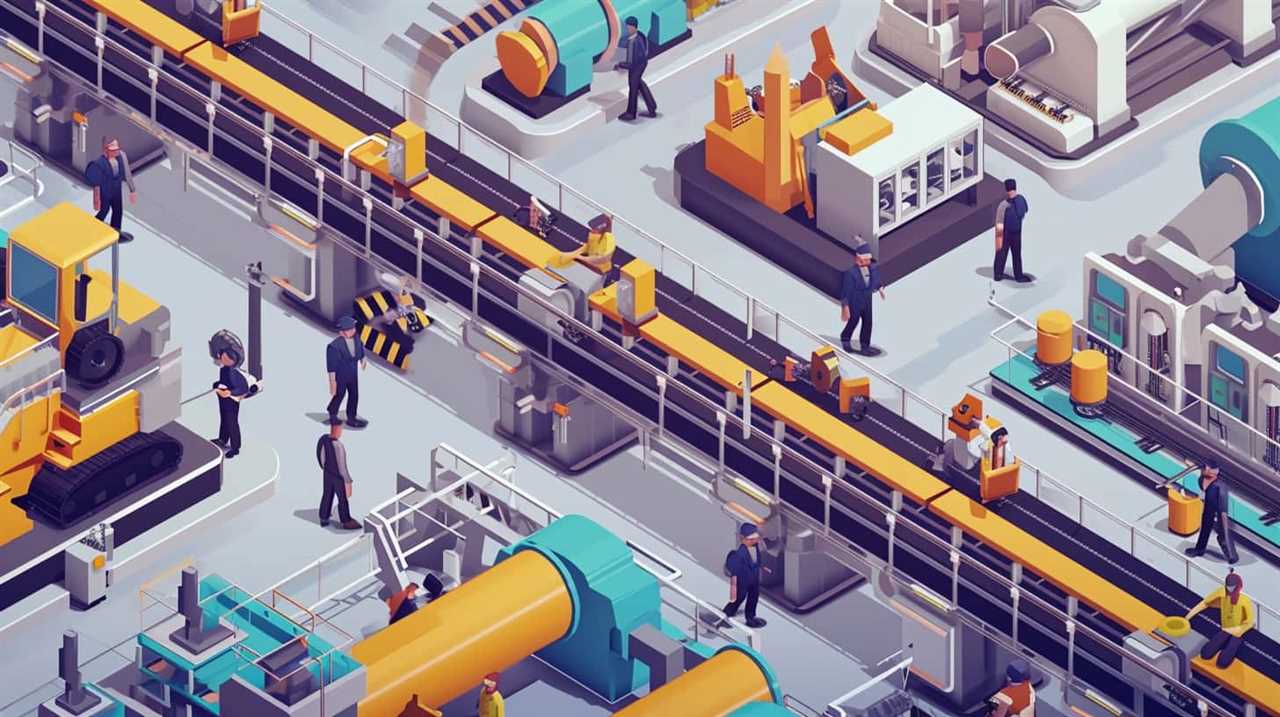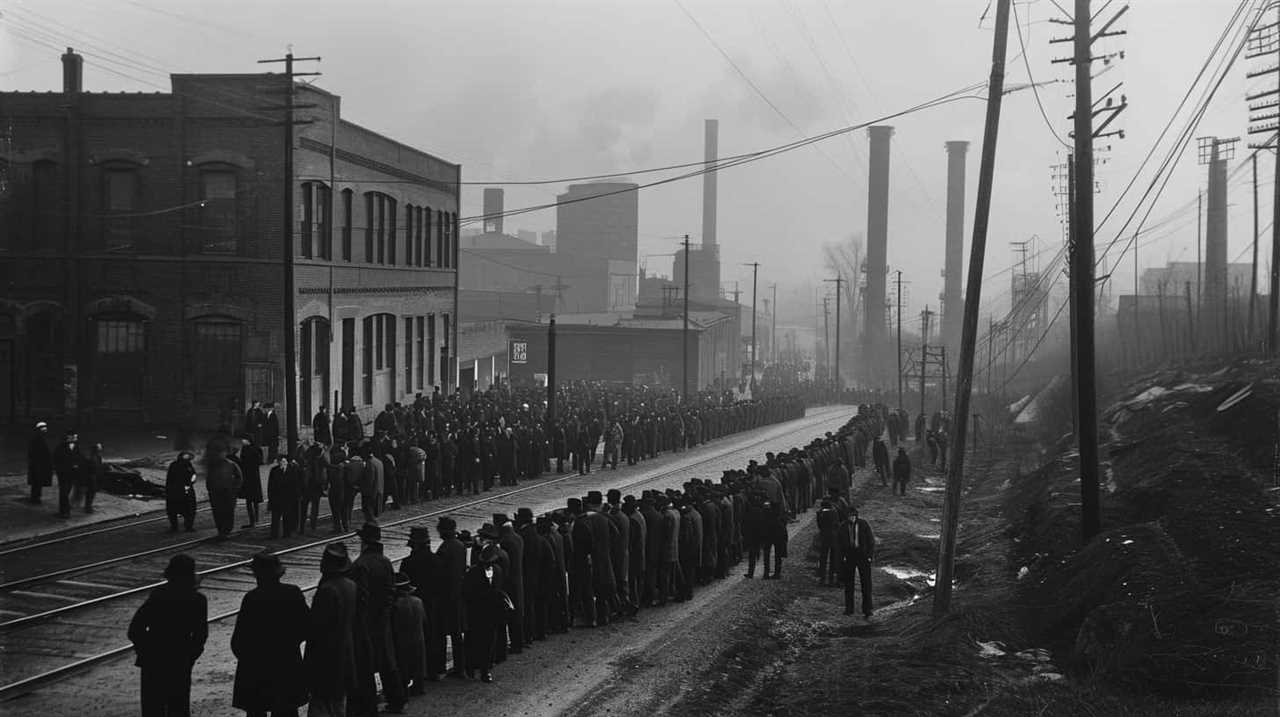Hello, fellow pioneers! Are you ready to delve into the world of Austrian economic theories? Get ready, because we have a special treat for you.
In this article, we’ll be exploring the wisdom of none other than Friedrich Hayek, a renowned economist and champion of free markets. We’ve scoured his works and handpicked the 7 best quotes that encapsulate the essence of Austrian economic principles.
From the importance of prices and market competition to the dangers of central planning, Hayek’s words will challenge your thinking and ignite your innovative spirit.
So, grab a cup of coffee, sit back, and get ready to be inspired by these powerful insights into the world of economics.

Let’s get started!
Key Takeaways
- Central planning inhibits the dynamic and adaptive nature of the market.
- The market, through the price mechanism, aggregates and coordinates dispersed knowledge.
- Central planning limits innovation.
- A decentralized market system fosters innovation.
Hayek on the Role of Prices
In our exploration of Hayek’s Austrian economic principles, we delve into Hayek’s insightful perspective on the indispensable role of prices. Hayek understood that prices weren’t just arbitrary numbers, but rather, they were powerful signals that conveyed important information about the supply and demand of goods and services in the market. He recognized the significance of price signals in guiding individuals and businesses to make informed decisions. When prices rise, it indicates that there’s increased demand for a particular product, signaling producers to allocate more resources towards its production. Conversely, when prices fall, it suggests a decrease in demand, prompting producers to reallocate resources elsewhere. This mechanism of price signals allows for the efficient allocation of resources in an economy.
Furthermore, Hayek cautioned against the harmful impact of price controls on the economy. He argued that when the government intervenes and sets price controls, it disrupts the natural equilibrium of supply and demand. Price controls create artificial shortages or surpluses, leading to inefficient resource allocation and distortions in the market. Hayek believed that price controls hindered the price system’s ability to transmit accurate information and coordinate economic activities effectively.
With an understanding of the significance of price signals and the detrimental effects of price controls, Hayek emphasized the importance of allowing market forces to determine prices. He advocated for free markets, where prices are determined through the voluntary interactions of individuals and businesses. By allowing prices to adjust freely, Hayek believed that the economy would achieve optimal resource allocation and promote innovation and prosperity.

Transitioning into the subsequent section about ‘Hayek on Spontaneous Order’, we’ll now explore how Hayek’s ideas on spontaneous order complement his perspective on the role of prices in the economy.
Hayek on Spontaneous Order
Continuing our exploration of Hayek’s Austrian economic principles, we delve into Hayek’s perspective on spontaneous order and its role in shaping the economy.
- Spontaneous order: Hayek believed that the economy isn’t a product of deliberate design or central planning, but rather emerges organically through the interactions of countless individuals. This concept, rooted in complexity theory, highlights the inherent complexity and unpredictability of economic systems.
- Complexity theory: Hayek argued that the economy is a complex adaptive system, influenced by a multitude of interconnected factors. This perspective challenges the notion that a centralized authority can effectively manage and control the economy. Instead, it emphasizes the importance of allowing decentralized decision-making and individual freedom to drive economic progress.
- Emergent behavior: According to Hayek, spontaneous order gives rise to emergent behavior, where patterns and structures emerge from the interactions of individuals without any central coordination. These emergent phenomena, such as market prices and social norms, play a crucial role in guiding economic activity and facilitating coordination.
- Implications for innovation: Hayek’s view on spontaneous order underscores the significance of innovation in driving economic growth. By allowing individuals the freedom to experiment, adapt, and respond to changing circumstances, spontaneous order fosters an environment conducive to innovation. This encourages the development of new technologies, products, and processes, ultimately leading to increased prosperity and progress.
Hayek’s perspective on spontaneous order challenges conventional wisdom and offers a fresh approach to understanding the dynamics of the economy. By embracing complexity theory and recognizing the power of emergent behavior, Hayek’s ideas provide valuable insights for those seeking to foster innovation and drive economic advancement.
Hayek on Market Competition
We frequently encounter Hayek’s insightful perspective on market competition and its role in the Austrian economic principles. Hayek believed that market competition is essential for promoting market efficiency and driving economic progress. According to Hayek, competition allows for the discovery and dissemination of vital information through price signals.

Hayek argued that market competition leads to a more efficient allocation of resources. When multiple firms compete in a market, they strive to offer better products or services at competitive prices. This competition incentivizes firms to innovate, improve productivity, and reduce costs. As a result, market efficiency is enhanced, leading to better outcomes for both producers and consumers.
Furthermore, Hayek emphasized the importance of price signals in a competitive market. Prices act as signals that convey information about the relative scarcity or abundance of goods and services. Through price signals, consumers are guided to make informed decisions about their purchases, while producers can adjust their production levels accordingly. This process ensures that resources are allocated efficiently and in line with consumer preferences.
Hayek on the Knowledge Problem
As we delve into Hayek’s insights on Austrian economic principles, it’s important to explore his perspective on the knowledge problem.
Hayek’s critique of central planning was centered around the idea that a central authority could never possess all the knowledge necessary to make efficient economic decisions. He argued that the dispersed knowledge held by individuals in the market was key to economic coordination and innovation.

Here is a breakdown of Hayek’s critique and his proposed solution to the knowledge problem:
- Critique: Hayek believed that central planners couldn’t possibly have access to the vast amount of local, tacit knowledge possessed by individuals in the market. This knowledge, he argued, was essential for efficient resource allocation and decision making.
- Solution: Hayek proposed that the market, through the price mechanism, was the most effective way to aggregate and coordinate this dispersed knowledge. Prices act as signals, conveying information about scarcity and demand, allowing individuals to make informed decisions about resource allocation.
- Critique: Hayek also argued that central planning stifled innovation. In a centrally planned economy, decisions are made based on limited information and static knowledge, inhibiting the dynamic and adaptive nature of the market.
- Solution: Hayek believed that a decentralized market system, with its trial and error process, would foster innovation. By allowing individuals the freedom to experiment, learn from failures, and adapt to changing circumstances, the market would generate new ideas and solutions.
Hayek’s insights on the knowledge problem highlight the importance of embracing decentralized decision-making processes and market mechanisms to harness the power of dispersed knowledge for economic efficiency and innovation.
Hayek on the Dangers of Central Planning
The dangers of central planning become evident when considering Hayek’s critique of the knowledge problem in Austrian economic principles. Hayek argued that the pitfalls of centralized decision making and the dangers of government intervention in the economy are rooted in the inability of any individual or group to possess the necessary knowledge to effectively plan and control economic activities. According to Hayek, the dispersed and decentralized nature of knowledge in society makes it impossible for a central authority to accurately gather and process all the information needed to make efficient economic decisions.
Central planning, Hayek believed, ignores the role of market prices as essential signals that convey valuable information about scarcity, demand, and the relative importance of goods and services. By replacing these market signals with centralized decision-making, governments risk distorting the allocation of resources, misallocating capital, and hindering innovation and economic growth.

Furthermore, Hayek argued that central planning limits individual freedom and stifles entrepreneurship. When governments make decisions about resource allocation, they restrict the ability of individuals to pursue their own interests, make their own choices, and engage in voluntary economic transactions. This lack of freedom and flexibility can lead to inefficiency, reduced incentive for innovation, and a decline in overall prosperity.
Hayek on Individual Liberty and Freedom
From the perspective of individual liberty and freedom, Hayek emphasizes the importance of limiting government intervention in economic affairs. Hayek argues that excessive government intervention stifles individual responsibility and hinders economic progress. Here are four key points that highlight Hayek’s views on this topic:
- Spontaneous Order: Hayek believed that the market, when left to its own devices, is capable of generating spontaneous order and coordinating the actions of individuals without the need for central planning. He saw this as a fundamental characteristic of a free society.
- Limited Government: Hayek advocated for a limited role of government in the economy, arguing that excessive intervention leads to unintended consequences, inefficiencies, and the erosion of individual freedom. He believed that the government should focus on maintaining the rule of law and protecting property rights.
- Individual Responsibility: Hayek stressed the importance of individual responsibility in a free society. He believed that individuals should have the freedom to make their own choices and bear the consequences of their actions. This fosters personal growth and ensures the efficient allocation of resources.
- Spontaneous Discovery: Hayek argued that individual freedom and decentralized decision-making allow for spontaneous discovery and innovation. When individuals are free to experiment and pursue their own interests, they can uncover new knowledge and create innovative solutions to societal problems.
With an understanding of Hayek’s perspective on individual liberty and freedom, we can now explore his views on the importance of property rights.
How Do Hayek’s Quotes Compare to Friedman’s Quotes on Economic Principles?
When comparing Hayek’s and Milton Friedman’s free market quotes, one can see similarities in their emphasis on individual freedom and limited government intervention. However, Hayek’s quotes often focus on the importance of spontaneous order, while Friedman’s emphasize the efficacy of free markets in allocating resources efficiently.
Hayek on the Importance of Property Rights
Continuing our exploration of Hayek’s views on individual liberty and freedom, let us now delve into his perspective on the importance of property rights. Hayek believed that property rights play a crucial role in promoting economic growth and fostering a free society. He argued that property rights are essential for individuals to exercise their freedom and make autonomous decisions.

Hayek emphasized the role of government in protecting property rights. He believed that the government should establish and enforce a legal framework that safeguards individuals’ right to own and control property. This includes protecting property from theft, trespassing, or seizure without just cause. By doing so, the government ensures that individuals can enjoy the fruits of their labor and have the incentive to invest in productive activities.
The impact of property rights on economic growth cannot be overstated. When individuals have secure property rights, they are more likely to engage in productive economic activities. They have the motivation to invest, innovate, and take risks, knowing that they will reap the benefits. This leads to increased productivity, entrepreneurship, and overall economic development.
In order to illustrate the importance of property rights, let’s take a look at the following table:
| Role of Government in Protecting Property Rights | Impact of Property Rights on Economic Growth |
|---|---|
| Establishing and enforcing a legal framework | Increased productivity and investment |
| Protection against theft and trespassing | Encouragement of entrepreneurship |
| Safeguarding property from unjust seizure | Fostering economic development |
Frequently Asked Questions
How Did Hayek Define Spontaneous Order and How Does It Relate to His Views on Individual Liberty and Freedom?
Hayek defined spontaneous order as the natural emergence of social and economic systems without central planning. He believed it fostered individual liberty and freedom by allowing individuals to make choices and engage in voluntary cooperation. This concept aligns with his belief in the benefits of market competition for society.

Can You Provide Examples of How Hayek Believed Market Competition Benefits Society?
Market competition, according to Hayek, benefits society in myriad ways. It fosters innovation, drives efficiency, and ensures consumer choice. By promoting individual liberty and freedom, it allows for a dynamic and prosperous economic system.
What Is the Knowledge Problem That Hayek Often Referred To, and How Does It Impact Central Planning?
The knowledge problem Hayek often referred to highlights the difficulty of central planning in efficiently allocating resources. Hayek argued that decentralized knowledge held by individuals in the market is crucial for economic coordination and innovation.
Did Hayek Believe That Government Intervention in the Economy Was Always Detrimental to Individual Liberty and Freedom?
Government intervention in the economy was not always seen by Hayek as detrimental to individual liberty and freedom. He believed that excessive intervention could lead to the erosion of personal freedoms, but recognized the need for some regulation to maintain a functioning society.
How Did Hayek Argue for the Importance of Property Rights in Fostering Economic Growth and Societal Well-Being?
Hayek argued for the importance of property rights in fostering economic growth and societal well-being. He believed that secure property rights incentivize individuals to invest, innovate, and create wealth, leading to overall prosperity and improved quality of life.

Conclusion
In conclusion, Friedrich Hayek’s quotes on Austrian economic principles provide insightful perspectives on the role of prices, spontaneous order, market competition, the knowledge problem, the dangers of central planning, individual liberty and freedom, and the importance of property rights.
These principles emphasize the importance of free markets, individual decision-making, and the limitations of central planning. As Hayek famously said, ‘The curious task of economics is to demonstrate to men how little they really know about what they imagine they can design.’
This quote encapsulates the essence of his belief in the decentralized nature of economic systems and the limits of human knowledge in shaping complex economies.
Lauren’s talent in writing is matched by her passion for storytelling. Her love for books and deep understanding of culture and entertainment add a distinct flavor to her work. As our media and press contact, Lauren skillfully bridges the gap between afterQuotes and the broader media landscape, bringing our message to a wider audience.










